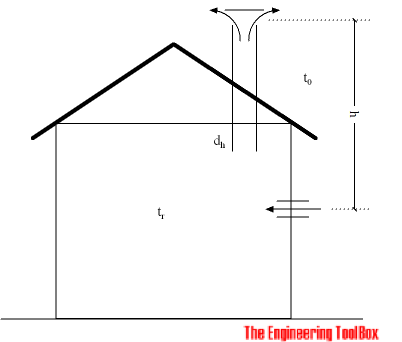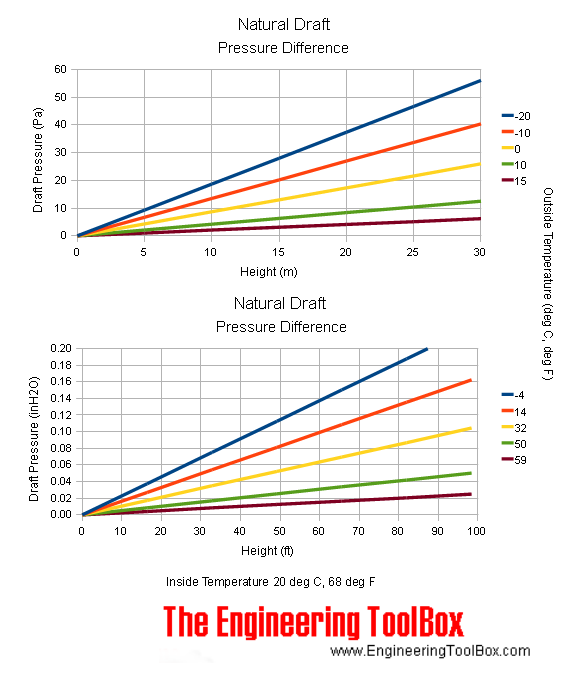Natural Draft - Air Flow Volume and Velocity
Air flow - volume and velocity - due to stack or flue effect caused by indoor hot and outdoor cold temperature difference.
The temperature difference between the outside air and the inside air creates a "natural draft" forcing air to flow through the building.
The direction of the air flow depends on the temperature of the outside and inside air. If the inside air temperature is higher than the outside air temperature, the inside air density is less than the outside air density, and the inside air will flow up and out of the upper parts of the building. The colder outside air will flow in to the lower parts of the building.
If the outside air temperature is higher than the inside air temperature - the inside air is more dense than the outside air - and the air flows down inside in the building. Warmer outside air flows in to the upper parts of the building.

Natural Draft Head
The natural draft head can be calculated as
dhmmH2O = 1000 h (ρo - ρr) / ρh2o (1)
where
dhmmH2O = head in millimeter water column (mm H2O)
ρo = density outside air (kg/m3)
ρr = density inside air (kg/m3)
ρh2o = density water (in general 1000 kg/m3)
h = height between outlet and inlet air (m)
Natural Draft Pressure
Equation (1) can be modified to SI pressure units:
dp = g ( ρo - ρr) h (1b)
where
d p = pressure (Pa, N/m2)
g = acceleration of gravity - 9.81 (m/s2)
Density and Temperature
With air density 1.293 kg/m 3 at 0 oC - the air density at any temperature can be expressed as
ρ = (1.293 kg/m3) (273 K) / (273 K + t) (2)
or
ρ = 353 / (273 + t) (2b)
where
ρ = density of air (kg/m3)
t = the actual temperature (oC)
Equation (1) above can easily be modified by replacing the densities with equation (2) .
Natural Draft Pressure Calculator
The calculator below can be used to calculate the natural draft pressure generated by the inside and outside temperature difference.
Major and Minor System Loss
The natural draft force will be balanced to the major and minor loss in ducts, inlets and outlets. The major and minor loss in the system can be expressed as
dp = λ (l / dh ) (ρr v2 / 2) + Σ ξ 1/2 ρr v2 (3)
where
dp = pressure loss (Pa, N/m2, lbf/ft2)
λ = Darcy-Weisbach friction coefficient
l = length of duct or pipe (m, ft)
dh = hydraulic diameter (m, ft)
Σ ξ = minor loss coefficient (summarized)
Air Flow and Air Velocity
Equation (1) and (3) can be combined to express the air velocity through the duct
v = ((2 g ( ρo - ρr ) h) / ( λ l ρr / dh + Σ ξ ρr ))1/2 (4)
Equation (4) can also be modified to express the air flow volume through the duct
q = π dh2 / 4 ((2 g (ρo - ρr ) h) / (λ l ρr / dh + Σ ξ ρr))1/2 (5)
where
q = air volume (m3/s)
Natural Draft Air Flow and Velocity Calculator
The calculator below can be used to calculate the air flow volume and velocity in a duct similar to the drawing above. The friction coefficient used is 0.019 which is appropriate for normal galvanized steel ducts.
Example - Natural Draft
Calculate the air flow caused by natural draft in a normal family house with two floors. The height of the hot air column from ground floor to outlet air duct above roof is approximately 8 m. The outside temperature is -10 oC and the inside temperature is 20 oC .
A duct of diameter 0.2 m goes from 1. floor to the outlet above the roof. The length of the duct is 3.5 m. Air leakages through the building are neglected. The minor coefficients are summarized to 1.
The density of the outside air can be calculated as
ρo = (1.293 kg/m3) (273 K) / ((273 K) + (-10 oC))
= 1.342 kg/m3
The density of the inside air can be calculated as
ρr = (1.293 kg/m3) (273 K) / ((273 K) + (20 oC))
= 1.205 kg/m3
The velocity through the duct can be calculated as
v = ((2 (9.81 m/s2) ((1.342 kg/m3) - (1.205 kg/m3)) (8 m)) / (0.019 (3.5m)(1.205 kg/m3 ) / (0.2 m) + 1 (1.205 kg/m3)))1/2
= 3.7 m/s
The air flow can be calculated as
q = (3.7 m/s) 3.14 (0.2 m)2 / 4
= 0.12 m3/s
Note!
that these equations can be used for dry air, not for mass flow and energy loss calculations where air humidity may have vast effects.




